Red Eye Gave A Famous Horror Director His Final Masterpiece
Though regarded as a good B-movie today, Red Eye proved that Wes Craven never lost his touch.

For director Wes Craven, the 2000s had their fair share of ups and downs. The horror luminary, who’d effectively revolutionized the genre for three straight decades prior, dealt with a mix of seemingly unkillable franchises (Scream 3 & 4), difficult productions (Cursed), and underperforming original efforts (My Soul To Take.) However, in the middle of these, he helmed Red Eye. Bearing a lean, tense narrative, a leading man that was in the midst of a bad guy hot streak, and the kind of stripped down thrills that powered Craven’s early work, Red Eye is a film that, on the 20th anniversary of its release, serves as a reminder of his eternally potent talent. The director definitely still “had it.”
In the film, Lisa Reisert (Rachel McAdams, proven a new star thanks to the one-two-three punch of Mean Girls, The Notebook and Wedding Crashers) is taking a red-eye flight back home after her grandmother’s funeral. At the airport, she befriends the impeccably named Jackson Rippner (Cillian Murphy), but their meet-cute spirals into a game of cat and mouse aboard the plane when Rippner reveals that he’s been sent by a terrorist organization to kill a prominent member of the Department of Homeland Security. And if Reisert, who works at the hotel the politician is staying at, doesn’t manage to get him moved to a room in the sights of the missile that Rippner’s terrorist pals have aimed at the hotel, he’ll kill her dad and probably her, too.
Though Reisert does eventually make it off the plane, where the movie turns from claustrophobic horror to a bit of a spy adventure, it’s most effective when Reisert and Rippner are trapped in economy class together. With little room available, Craven shoots much of the film in either anxious close-ups or intimate two-shots, and the first half of the film might be the closest Craven ever got to emulating Alfred Hitchcock. Being in such close proximity without an exit turns the two leads into a powder keg, and it’s only when violence does eventually explode (Reisert stabs Rippner in the neck with a pen and escapes the airport), that we get a respite. It’s a shame that the more typical “chase” structure of the rest of the film never quite lives up to its early promise.
That barrage of close-ups also allows us to spend time gazing in the bewitching blue eyes of Cillian Murphy, eyes that can appear thoughtful one moment and malevolent the next. Craven obviously found Murphy to be an appealing on-camera subject, just as director Christopher Nolan did earlier in the summer of 2005 when he cast Murphy as Batman foe, the Scarecrow, in Batman Begins. It wasn’t the Irish actor’s first time in the international spotlight (he’d been wonderful as Jim in 28 Days Later, freshly awakened from a coma to discover a zombie apocalypse), but these two films solidified Murphy as 2005’s villain actor of the summer. No line reading in Red Eye is quite as memorable as, for instance, the way he curiously delivers “The Baaat…maaaan” in Begins, but his quiet intensity shows that you don’t need to lug around fifty pounds of extra muscle to be a fantastic antagonist.
Cillian Murphy’s Jackson Rippner was a chilling horror villain for the ages.
After Reisert manages to flee the airport, the film struggles a bit as plot threads involving the eventually-foiled assassination are wrapped up and the terrorists are vanquished. Rippner does get one more chance to shine in the climax, and he stalks Reisert around a house while holding a massive hunting knife and maintaining a Michael Myers-esque wheeze (thanks to his aforementioned throat injury.) Craven’s obviously in his classic depth here — a career of making multiple Screams, two installments in The Hills Have Eyes, and various takes on A Nightmare on Elm Street means that he’s right at home in slasher territory. But seeing Rachel McAdams as a satisfying “Final Girl” eludes us here: When Rippner is eventually killed, he’s taken down by Reisert’s father.
Today, Cillian Murphy regards Red Eye as a “good B movie,” mostly worthwhile for the fun he had acting alongside McAdams. And though, critically, it’s a far cry from where he’d end up (winning the Academy Award for Best Actor in Oppenheimer, as opposed to his nomination for “Choice Villain” at the 2006 Teen Choice Awards), Red Eye is a solid crowd pleaser with its lengthy section aboard the plane being tightly and ingeniously constructed. Most importantly, however, it showed that Wes Craven had not lost a step in crafting the kinds of flicks that he made his name off of. The final years of his career were far from easy and Craven always longed to break outside the reputation of just being adept at horror films. But Red Eye was proof of why he’ll be forever tied to them, with the genre that we know today resting on his shoulders.